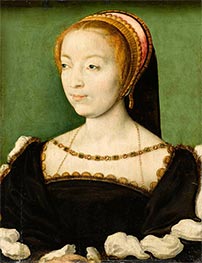
Corneille de Lyon Painting Reproductions 1 of 1
1500-1575
French Northern Renaissance Painter
Corneille de Lyon, a painter whose life and work are intertwined with the French court of the 16th century, remains an enigmatic figure. Born in The Hague around 1500, he migrated to Lyon, where he spent most of his life, and his name became forever associated with that city. While little is known about his early training, it is likely he was influenced by Netherlandish traditions, which helped shape his meticulous and intimate approach to portraiture. His first documented appearance was in 1533, when he was visited in Lyon by the poet Jean Second. A year later, he was already the official painter to Eleonore of Austria, Queen of France, and by 1541, he was serving the dauphin, the future King Henri II.
Corneille’s portraits stand apart from many of his contemporaries. His canvases are small, often just bust-length depictions of French courtiers, but within these tight frames, he captured an astonishing sense of character. His paintings are not grand, rhetorical works; they are quiet, observational pieces. The sitter’s face emerges against a vivid green or blue background, with an intensity that draws the viewer in. These portraits aren’t just depictions of power or wealth; they feel personal, offering glimpses of humanity within the formality of court life.
By the time Henri II ascended the throne in 1547, Corneille had cemented his position as a court favorite. He became "peintre et premier valet de chambre", a rare honor, and was naturalized as a French citizen in the same year. His clients came from all levels of court society, from the highest nobility to the wealthier bourgeoisie. Contemporary accounts describe his studio in Lyon filled with small portraits of the court’s most influential figures. Visitors, such as the Venetian ambassador Giovanni Capello, noted how Corneille’s works captured with remarkable naturalism the likenesses of princes, princesses, and courtiers. Catherine de' Medici and Charles IX themselves visited his studio in 1564, further underscoring his importance at court.
Corneille de Lyon’s works survive as vital documents of 16th-century French society. Around 200 of his paintings are attributed to him, and though they share a uniformity in format, they brim with individuality and technical finesse. His later works, marked by looser brushwork and subtler use of shadow, show an evolution in his style, though his commitment to intimacy and immediacy never wavered. His portraits serve not only as records of historical figures but as testaments to his ability to distill the essence of his subjects with sensitivity and skill. Corneille died in 1575, leaving behind a body of work that, while modest in size, carries a profound sense of artistry and insight into the human soul.
Corneille’s portraits stand apart from many of his contemporaries. His canvases are small, often just bust-length depictions of French courtiers, but within these tight frames, he captured an astonishing sense of character. His paintings are not grand, rhetorical works; they are quiet, observational pieces. The sitter’s face emerges against a vivid green or blue background, with an intensity that draws the viewer in. These portraits aren’t just depictions of power or wealth; they feel personal, offering glimpses of humanity within the formality of court life.
By the time Henri II ascended the throne in 1547, Corneille had cemented his position as a court favorite. He became "peintre et premier valet de chambre", a rare honor, and was naturalized as a French citizen in the same year. His clients came from all levels of court society, from the highest nobility to the wealthier bourgeoisie. Contemporary accounts describe his studio in Lyon filled with small portraits of the court’s most influential figures. Visitors, such as the Venetian ambassador Giovanni Capello, noted how Corneille’s works captured with remarkable naturalism the likenesses of princes, princesses, and courtiers. Catherine de' Medici and Charles IX themselves visited his studio in 1564, further underscoring his importance at court.
Corneille de Lyon’s works survive as vital documents of 16th-century French society. Around 200 of his paintings are attributed to him, and though they share a uniformity in format, they brim with individuality and technical finesse. His later works, marked by looser brushwork and subtler use of shadow, show an evolution in his style, though his commitment to intimacy and immediacy never wavered. His portraits serve not only as records of historical figures but as testaments to his ability to distill the essence of his subjects with sensitivity and skill. Corneille died in 1575, leaving behind a body of work that, while modest in size, carries a profound sense of artistry and insight into the human soul.
1 Corneille de Lyon Paintings

Louise de Rieux c.1550
Oil Painting
$1118
$1118
Canvas Print
$54.62
$54.62
SKU: LYC-18001
Corneille de Lyon
Original Size: 16 x 12 cm
Louvre Museum, Paris, France
Corneille de Lyon
Original Size: 16 x 12 cm
Louvre Museum, Paris, France